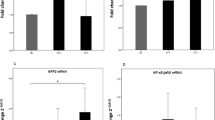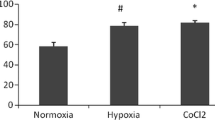Abstract
Hyperbaric oxygen (HBO) is thought to confer protection to cells via a cellular response to free radicals. This process may involve increased expression of heat shock proteins, in particular the highly inducible heat shock protein 72 (Hsp72). Healthy male volunteers (n = 16) were subjected to HBO for 1 h at 2.8 ATA. Inducible Hsp72 expression was measured by flow cytometry pre-, post- and 4 h-post HBO. Peripheral blood mononuclear cells (PBMC) were isolated from whole blood via density centrifugation pre-, post- and 4 h post-HBO. PBMC were then subjected to an in vitro heat shock at 40°C or hypoxia at 37°C (5% O2) with a control at 37°C. Cells were then analysed for Hsp72 expression by flow cytometry. Monocytes showed no significant changes in Hsp72 expression following HBO. No detectable Hsp72 was seen in lymphocytes or neutrophils. Following in vitro hypoxic exposure, a significant increase in Hsp72 expression was observed in monocytes isolated immediately post- (p = 0.006) and 4 h post-HBO (p = 0.010) in comparison to control values. HBO does not induce Hsp72 expression in PBMC. The reported benefits of HBO in terms of pre-conditioning are not due to inducement of Hsp72 expression in circulating blood cells, but may involve an enhancement of the stress response.

Similar content being viewed by others
References
Alex J, Laden G, Cale ARJ, Bennett S, Flowers K, Madden L, Gardiner E, McCollum PT, Griffin SC (2005) Pretreatment with hyperbaric oxygen and its effect on neuropsychometric dysfunction and systemic inflammatory response after cardiopulmonary bypass: a prospective randomized double-blind trial. J Thorac Cardiovasc Surg 130:1623–1630
Bachelet M, Mariethoz E, Banzet N, Souil E, Pinot F, Polla CZ, Durand P, Bouchaert I, Polla BS (1998) Flow cytometry is a rapid and reliable method for evaluating heat shock protein 70 expression in human monocytes. Cell Stress Chaperones 3:168–176
Benedetti S, Lamorgese A, Piersantelli M, Pagliarani S, Benvenuti F, Canestrari F (2004) Oxidative stress and antioxidant status in patients undergoing prolonged exposure to hyperbaric oxygen. Clin Biochem 37:312–317
Bukau B, Horwich AL (1998) The Hsp70 and Hsp60 chaperone machines. Cell 92:351–366
Clifton GL (1995) Hypothermia and hyperbaric oxygen as treatment modalities for severe head injury. New Horiz 3:474–478
Conconi MT, Baiguera S, Guidolin D, Furlan C, Menti AM, Vigolo S, Belloni AS, Parnigotto PP, Nussdorfer GG (2003) Effects of hyperbaric oxygen on proliferative and apoptotic activities and reactive oxygen species generation in mouse fibroblast 3 T3/J2 cell line. J Investigativ Med 51:227–232
Currie RW, Karmazyn M, Kloc M, Mailer K (1988) Heat shock response is associated with enhanced post-ischemic ventricular recovery. Circ Res 63:543–549
Dekleva M, Neskovic A, Vlahovic A, Putnikovic B, Beleslin B, Ostojic M (2004) Adjunctive effect of hyperbaric oxygen treatment after thrombolysis on left ventricular function in patients with acute myocardial infarction. Am Heart J 148:E14
Dennog C, Radermacher P, Barnett YA, Speit G (1999) Antioxidant status in humans after exposure to hyperbaric oxygen. Mutat Res Fundam Mol Mech Mutagen 428:83–89
Gregorevic P, Lynch GS, Williams DA (2001) Hyperbaric oxygen modulates antioxidant enzyme activity in rat skeletal muscles. Eur J Appl Physiol 86:24–27
Kregel KC (2002) Heat shock proteins: modifying factors in physiological stress responses and acquired thermotolerance. J Appl Physiol 92:2177–2186
Kukreja RC, Kontos MC, Loesser KE, Batra SK, Qian YZ, Gbur CJ, Naseem SA, Jesse RL, Hess ML (1994) Oxidant stress increases heat-shock protein-70 messenger-RNA in isolated-perfused rat-heart. Am J Physiol Heart Circ Physio 267:H2213–H2219
Larsson A, Uusijärvi J, Eksborg S, Lindholm P (2010) Tissue oxygenation measured with near-infrared spectroscopy during normobaric and hyperbaric oxygen breathing in healthy subjects. Eur J Appl Physiol. doi:10.1007/s00421-00010-01403-00420
Locke M, Noble EG (1995) Stress proteins—the exercise response. Can J Appl Physiol 20:155–167
Madden LA, Sandstrom ME, Lovell RJ, McNaughton L (2008) Inducible heat shock protein 70 and its role in preconditioning and exercise. Amino Acids 34:511–516
Madden LA, Vince RV, Laden G (2010a) The effect of acute hyperoxia in vivo on NF kappa B expression in human PBMC. Cell Biochem Func. doi:10.1002/cbf.1712
Madden LA, Chrismas B, Mellor D, Vince RV, Midgley AW, McNaughton L, Atkin SL, Laden G (2010b) Endothelial function and stress response after simulated dives to 18msw breathing air or oxygen. Aviat Space Environ Med 81:41–45
Mathieu DCJ, Vinckier F, Saulnier A, Durocher ET, Wattel F (1984) Red blood cell deformability and hyperbaric oxygen. Med Subaquatique Hyperbar 3:100–104
Mocanu MM, Steare SE, Evans MCW, Nugent JH, Yellon DM (1993) Heat-stress attenuates free-radical release in the isolated-perfused rat-heart. Free Radical Biol Med 15:459–463
Oh E, Oh S, Im H, Lee J, Kim J, Moon J, Hong E, Kim Y, Yang M, Lim Y, Park S, Lee E, Sul D (2005) Effects of hyperbaric pressure on cellular morphology, proliferation and protein expression of Jurkat cell. Mol Cellul Toxicol 1:116–123
Patel B, Khaliq A, JarvisEvans J, Boulton M, Arrol S, Mackness M, McLeod D (1995) Hypoxia induces HSP 70 gene expression in human hepatoma (HEP G2) cells. Biochem Mol Biol Int 36:907–912
Roeckl-Wiedmann I, Bennett M, Kranke P (2005) Systematic review of hyperbaric oxygen in the management of chronic wounds. Brit J Surg 92:24–32
Rothfuss A, Radermacher P, Speit G (2001) Involvement of heme oxygenase-1 (HO-1) in the adaptive protection of human lymphocytes after hyperbaric oxygen (HBO) treatment. Carcinogen 22:1979–1985
Sandstrom ME, Madden LA, Taylor L, Siegler JC, Lovell RJ, Midgley A, McNaughton L (2009) Variation in basal heat shock protein 70 is correlated to core temperature in human subjects. Amino Acids 37:279–284
Shandling AH, Ellestad MH, Hart GB, Crump R, Marlow D, VanNatta B, Messenger JC, Strauss M, Stavitsky Y (1997) Hyperbaric oxygen and thrombolysis in myocardial infarction: the “HOT MI” Pilot Study. Am Heart J 134:544–550
Shinkai M, Shinomiya N, Kanoh S, Motoyoshi K, Kobayashi H (2004) Oxygen stress effects on proliferation rates and heat shock proteins in lymphocytes. Aviat Space Environ Med 75:109–113
Shyu WC, Lin SZ, Saeki K, Kubosaki A, Matsumoto Y, Onodera T, Chiang MF, Thajeb P, Li H (2004) Hyperbaric oxygen enhances the expression of prion protein and heat shock protein 70 in a mouse neuroblastoma cell line. Cellul Mol Neurobiol 24:257–268
Taylor L, Midgley AW, Chrismas B, Madden LA, Vince RV, McNaughton LR (2010) The effect of acute hypoxia on heat shock protein 72 expression and oxidative stress in vivo. Eur J Appl Physiol 109:849–855
Thom SR (2009) Oxidative stress is fundamental to hyperbaric oxygen therapy. J Appl Physiol 106:988–995
Thomas MP, Brown LA, Sponseller DR, Williamson SE, Diaz JA, Guyton DP (1990) Myocardial infarct size reduction by the synergistic effect of hyperbaric oxygen and recombinant tissue plasminogen activator. Am Heart J 120:791–800
Veltkamp R, Tooke JF (1997) Hyperbaric oxygen—a neuroprotective adjunct for hyperacute ischemic stroke? J Neurol Sci 150:1–2
Vince RV, McNaughton LR, Taylor L, Midgley AW, Laden G, Madden LA (2009) Release of VCAM-1 associated endothelial microparticles following simulated SCUBA dives. Eur J Appl Physiol 105:507–513
Vince RV, Oliver K, Midgley A, McNaughton L, Madden LA (2010) In vitro heat shock of human monocytes results in a proportional increase of inducible Hsp70 expression according to the basal content. Amino Acids 38:1423–1428
Weaver LK, Howe S, Snow GL, Deru K (2009) Arterial and pulmonary arterial hemodynamics and oxygen delivery/extraction in normal humans exposed to hyperbaric air and oxygen. J Appl Physiol 107:336–345
Yogaratnam JZ, Laden G, Madden LA, Guvendik L, Cowen M, Greenman J, Seymour A-M, Cale A, Griffin S (2007) Hyperbaric oxygen preconditioning safely improves myocardial function, promotes pulmonary vascular flow, and protects the endothelium from ischemic reperfusion injury. Cardiovasc Revascul Med 8:148–151
Acknowledgements
The authors wish to thank the staff of the Hull Hyperbaric Unit for their expertise and assistance, in particular Carol Compton-Mudd, and also Lee Taylor and Lars McNaughton for their input. The work described was internally funded.
Conflict of interest
None declared
Author information
Authors and Affiliations
Corresponding author
Rights and permissions
About this article
Cite this article
Vince, R.V., Midgley, A.W., Laden, G. et al. The effect of hyperbaric oxygen preconditioning on heat shock protein 72 expression following in vitro stress in human monocytes. Cell Stress and Chaperones 16, 339–343 (2011). https://doi.org/10.1007/s12192-010-0246-2
Received:
Revised:
Accepted:
Published:
Issue Date:
DOI: https://doi.org/10.1007/s12192-010-0246-2




